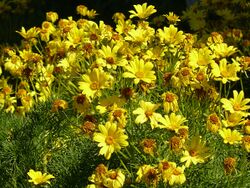Biology:Coreopsis gigantea
| Coreopsis gigantea | |
|---|---|

| |
| Scientific classification | |
| Kingdom: | Plantae |
| Clade: | Tracheophytes |
| Clade: | Angiosperms |
| Clade: | Eudicots |
| Clade: | Asterids |
| Order: | Asterales |
| Family: | Asteraceae |
| Genus: | Coreopsis |
| Species: | C. gigantea
|
| Binomial name | |
| Coreopsis gigantea (Kellogg) H.M. Hall[1]
| |
| Synonyms[2][3] | |
| |
Coreopsis gigantea, known by the common name giant coreopsis, is a woody perennial plant native to coastal regions of central and southern California and also to northern Baja California.[2][4][5]
Description
The stem of Coreopsis gigantea is a trunk up to 1 metre (3 1⁄2 feet) tall, and 4–10 centimetres (1 1⁄2–4 inches) in diameter. The plant can reach 3 m (10 ft) high by 0.61 m (2 ft) wide.[6][7] It is summer deciduous, leaving a sculptural bare trunk and branches during the dry season.
Bright green leaves and flowers are on the top of the trunk, while the rest of the trunk is bare. The leaves are up to 30 cm (12 in) long.[7]
The numerous flowers are yellow, daisy-like, 6–20 cm (2 1⁄2–8 in) in diameter. It blooms from the spring to early summer.[6]
The related C. maritima is found in similar areas.[7]
Distribution and habitat
The plant is found in California coastal sage and chaparral habitats, from 14–55 m (45–180 ft) in elevation.[2][6] It is found in coastal dunes, chaparral hillsides, and exposed sea bluff habitats.[6]
It is distributed on the coasts of: Southern California and the Channel Islands; the Central Coast region; San Francisco Bay Area; and in Mexico on the northwestern Baja California Peninsula and Guadalupe Island.[2]
It is restricted to nearly frost-free habitats because its stem is succulent, being cold tolerant to around 25 °F (−4 °C).[8] Storing water in this way makes the plants tolerant of drought but especially susceptible to frost.
Cultivation
Giant Coreopsis is cultivated as an ornamental plant by specialty nurseries.[6][8] It is planted in native plant, drought tolerant, and wildlife gardens, and in natural landscaping and habitat restoration projects.[8]
The plant needs good drainage and is not tolerant of excess moisture, needing minimal watering during the summer.[8][9]
References
- ↑ ITIS 37133
- ↑ 2.0 2.1 2.2 2.3 Jepson eFlora: Leptosyne gigantea . accessed 2.28.2015
- ↑ The Plant List, Coreopsis gigantea (Kellogg) H.M.Hall
- ↑ United States Department of Agriculture plants profile: Coreopsis gigantea . accessed 2.28.2015
- ↑ Calflora taxon report, University of California: Leptosyne gigantea . accessed 2.28.2015
- ↑ 6.0 6.1 6.2 6.3 6.4 "Theodore Payne Foundation California Natives Wiki: Coreopsis gigantea (Giant Coreopsis)". http://www.theodorepayne.org/mediawiki/index.php?title=Coreopsis_gigantea.
- ↑ 7.0 7.1 7.2 Spellenberg, Richard (2001). National Audubon Society Field Guide to North American Wildflowers: Western Region (rev ed.). Knopf. pp. 367–368. ISBN 978-0-375-40233-3. https://archive.org/details/nationalaudubons00spel/page/367/.
- ↑ 8.0 8.1 8.2 8.3 Las Pilitas Horticulture Database: Coreopsis gigantea, Giant Coreopsis
- ↑ San Marcos Growers database: Coreopsis gigantea
External links
- UC— Jepson Manual treatment for Leptosyne gigantea (Coreopsis gigantea)
- Leptosyne gigantea (Coreopsis gigantea) — Calphotos Photo gallery, University of California
- San Francisco Chronicle: "Coreopsis is supersize on the Channel Islands" — Sullivan, R. & J. Eaton; October 8, 2008.
Wikidata ☰ Q4232929 entry
 |

